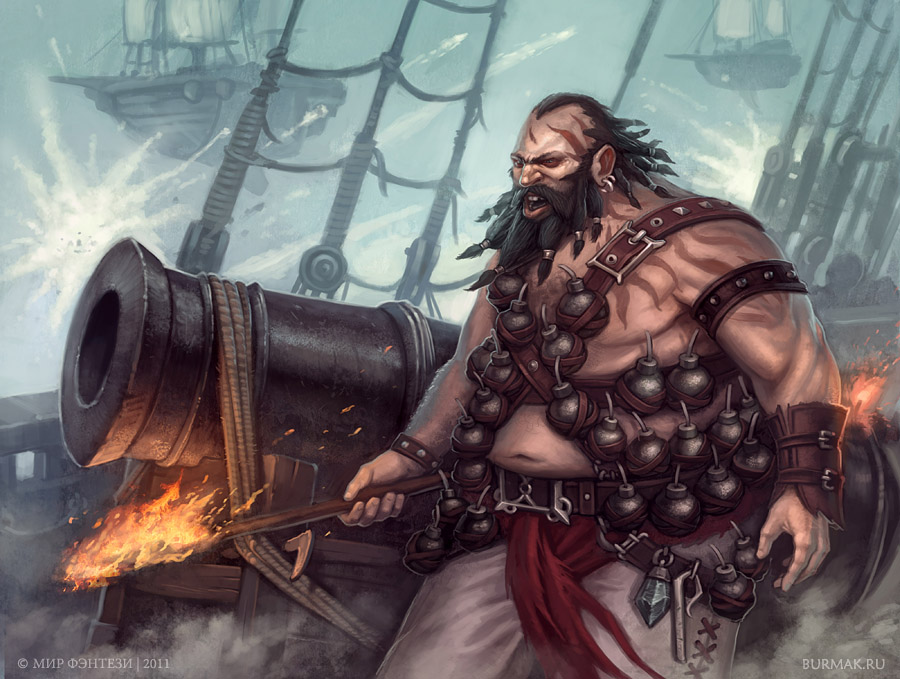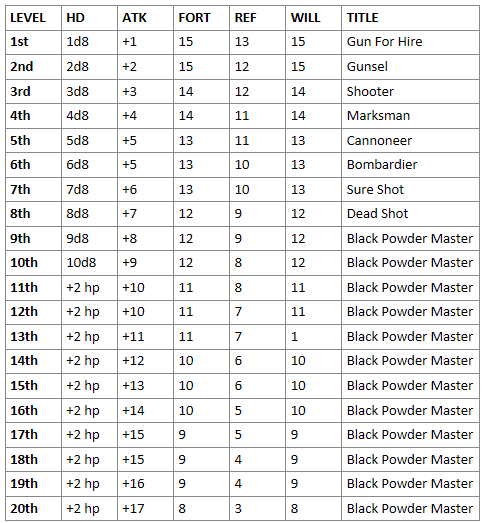So, in the first part, we discussed what issues we need to consider when adding black powder weapons to a D&D-derived fantasy world.
In the second, we checked out D&D and Pathfinder's current iterations of firearms to see if we could steal anything fun.
In this one, we will delve into the dark, murky and sometimes controversial world of the OSR to see what we can glean.
Starting with a personal favourite, Small But Viscous Dog - the rotten lovechild of B/X and WFRP.
Firearms are fairly deadly (as befits a WFRP-alike). They ignore armour at close range, which is more difficult to model in games where you fight monsters. They also have high damage dice, which can be a swingy way of representing the damage of firearms.
I had considered ignoring armour, but as the game is a swashbuckling pirate game, most people won't be wearing armour at all, so it's a bit of a moot point. I would like armour to be something worth using, so I will keep AC against firearm attacks. Makes more sense to me, at least.
AD&D 2e had the famous "Green Books" - the Historical Reference collection. We are interested in A Mighty Fortress, which covered the Elizabethan Age (and a bit after that as well). As with most things AD&D, there are a collection of awkward, exception-based rules for firearms which make them somewhat difficult to track on the tabletop.
At close range, firearms once again ignore armour; at medium range, the target's AC is penalised by 5, and at long range AC is penalised by 2. There are very loose rules for cover (i.e. it must be more "substantial" to qualify for the cover bonus; no rules are given past that. These firearms also given exploding damage dice, which is a fun idea and a good way to represent the inherent deadliness of firearms.
There are also rules for misfires, hang fire, fouled weapons from excessive use and point-blank firing. It's fairly extensive, but feels like it might bog down the game.
I can see allowing exploding damage die for crits with firearms, rather than simple double damage; that could be a fun little wrinkle. Otherwise, the other rules feel a bit excessive, and I don't mind combining fouling, hang fire and misfires into the fiction of rolling a natural 1.
 |
| The Ladies of LotFP, Preparing For a Fight! |
As part of the Early Modern setting that became part of the game as it developed, LotFP includes pistols, muskets and arquebuses, in matchlock, wheellock and flintlock varieties. It even has rules for rifling!
Again, firearms ignore armour at close range.
This brings the idea as to what sort of firearms I want present. I like the idea of having all three firing mechanisms present; it's a little bit anachronistic, but I like having the option of some areas being underequipped, while some are able to afford much nicer weapons. You can find small smithies cranking out simple arquebus-style guns, but if you want a proper rifle, you need to find a professional gunsmith.
We'll end on Adventurer Conqueror King (ACKS). Now, I generally don't recommend the system - the author is not only kind of a shitty dude, but he also supports a lot of other shitty dudes. It's also obsessed with minutiae and detail, in a way that isn't as much fun as it thinks it is, and the rules aren't free in any respect.
If you really want to read ACKS, my advice would be to read what sort of game this is for and act accordingly. Yo ho!
ACKS has the Guns of War supplement, which feels very similar to LotFP's (no doubt a result of using the same historical basis of the Pike & Shotte era). All firearms do 1d8 damage, pistols have ranges of 25ft/50ft/100ft, while rifles are 50/100/200. Weapons have detailed time to reload (for both trained and untrained soldiers), with bonuses to reload times for high Dexterity, penalties for being over burdened, items to reduce the loading time, several types of ammunition...
It's just a bit much, honestly. There's nothing here that wasn't covered elsewhere, better.







